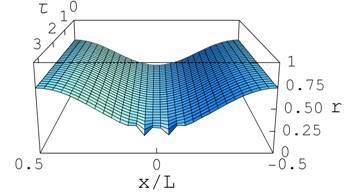
ACS PRF | ACS
All e-Annual Reports

45169-AC9
Physical Foundations of the Vibratory Recovery of Residual Oil
The work during the first year has mostly focused on the studies of the surface-tension-driven break-up of non-wetting oil droplets in constricted capillaries. This work has been submitted to refereed journals (Beresnev, 2007; Beresnev et al., 2007) (see references at the bottom). The first article deals with understanding the general physical conditions for the break-up, while the second with the development of an accurate analytical model of the phenomenon, as the two following sections illustrate.
Condition for the break-up of non-wetting fluids in sinusoidally constricted capillary channels
This study establishes a generic geometric condition that allows or prohibits the break-up of a non-wetting fluid (oil) surrounded by water in an axisymmetric channel with sinusoidal profile. Overlooking such a criterion has consistently been a shortcoming of previous studies. Establishing it, on the other hand, provides a unifying framework in which results of miscellaneous published observations can be understood.
Capillary-pressure (P) distribution along the oil core in the channel is calculated using
λ > 2π (rmin rmax)1/2. (1)
For the channel with a wavelength λ satisfying (1), the oil will spontaneously break up into isolated droplets, while, at shorter wavelengths, it will equilibrate into a cylindrical shape with constant radius. Note that equation (1), applied to a cylindrical tube (rmin = rmax = R), reduces to the well-known condition for the Plateau-Rayleigh instability, λ > 2πR. It thus generalizes the latter for the case of a constricted capillary.
The validity of the criterion (1) was verified in a computational-fluid-dynamics experiment using commercial code FLUENT. Figure 1 shows the evolution of an oil ganglion, surrounded by water, in the tube geometry satisfying condition (1), illustrating the full process of choke-off. A series of simulations were run for the values of λ bracketing its predicted threshold (1). This simple geometric criterion was found to be correct within about 12 %, showing its surprisingly high accuracy, considering that it does not account for the dynamics of the interface.
Quantitative dynamics of the choke-off process
While criterion (1) developed by Beresnev et al. (2007) correctly prescribes the geometry sufficient for the break-up, it has been called static because it does not take the interface dynamics into account. To make up for the lack of the dynamic description, Beresnev (2007) developed an evolution equation that provides an analytical model of the phenomenon. The equation follows from capillary-pressure analysis in the oil phase, combined with the conservation of mass in the approximation of the “small slope” of the pore wall.
For an axisymmetric capillary channel and in dimensionless variables, the radial position of the interface κ(x, τ) is described by the nonlinear equation
dκ/dτ = –(1/8κ) ∂/∂x {[κ2/2 + (μ1/μ2) (λ2 – κ2)](dκ/dx + κ2 d3κ/dx3)}, (2)
where x and τ are the dimensionless axial coordinate and time, respectively; λ(x) is the sinusoidal wall profile, and μ1/μ2 is the ratio of the oil-to-water dynamic viscosities. The spatial variables are non-dimensionalized by rmax and time by the characteristic time scale μ1rmax/σ, where σ is oil-water interfacial tension.
Equation 2 was solved numerically using computer package Mathematica®. Figure 2 presents the evolution of an interface that initially followed the wall profile, for the case in which condition (1) was satisfied. The first time “slice” (at the rear of the plot) is the initial fluid/fluid interface. Driven by the excess pressure in the neck, the fluid starts outflowing into the crests, which leads to the pinch-off in the neck. The break-up in this particular example is achieved through the formation of “wavy” features on the profile.
A combination of geometric criterion (1) and an analytical tool (2) provide a complete understanding of the process of oil break-up in sinusoidally constricted channels. With these models, the process of disintegration of oil into smaller droplets in petroleum reservoirs will be better understood.
b
![]()
Beresnev,
Beresnev, Figure 1. Computational-fluid-dynamics simulation of the evolution of an oil ganglion initially filling a pore. Figure 2. Evolution of a sinusoidal oil/water interface to a complete break-up. 



